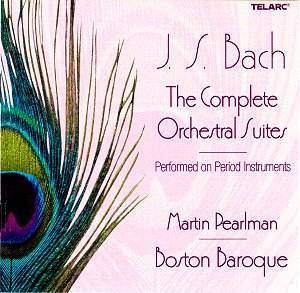This issue is at full
price, and for me, worth every penny.
It is without exception the best integral
recording of Bach’s four suites on a
single disc, and better than most of
the double disc issues as well. It is
the first period performance that I
can listen to without thinking "Oh
yes, this is a period performance."
Boston Baroque is a
new ensemble to me, although the sleeve
notes advertise a further 13 issues,
none of which I have heard. Listening
to this disc, it brought back very pleasant
memories of walking through shopping
malls in central Boston, and hearing
musicians busking in the precincts of
the shopping areas. In those days (mid-1970s)
there were not many period instruments
around, but the qualities of the playing
on this disc were very much in evidence
– absolute security of pitch and rhythm
and a joy in the playing which was very
satisfying.
Initially, I was surprised
that Telarc had placed these suites
in non-numerical order until I read
the notes. Evidently recent scholarship
has uncovered the fact that the order
of the suites - 4, 1, 3 and 2 is the
sequence in which they were written.
The same scholarship has uncovered the
fact that the fourth suite is now almost
definitely by Bach, where previously
this was thought not to be the case.
The Fourth Suite utilises
the largest forces of the four with
additional trumpets (3), timpani, and
oboe. When they are at full blast they
make a joyous sound, which the Telarc
engineers have captured wonderfully.
The last movement is called Réjouissance
and in this version this really
sounds as though it is a rejoicing;
many others run at it like a bull at
a gate which is often exciting but a
little out of character. Under Pearlman
the Boston Baroque are rejoicing like
no other band.
The Second Suite is
similarly lively, and beautifully played
with the overture and ten dances played
perfectly with security of both pitch
and rhythm, to say nothing of togetherness.
The overall spirit of the playing is
highly infectious and gave me much pleasure.
It is difficult to find any of the hallmarks
of older period performances – poor
pitch and rhythm to say nothing about
intonation.
When we reach the Third
Suite this, the most popular of the
four, is played with such élan
that it is hard to believe that we are
listening to a recording such is the
energy and commitment of the playing.
The Second Suite, last
on the disc, is the one for solo flute,
strings and harpsichord, and can be
considered as a flute concerto. The
soloist, Christopher Krueger is the
flautist with Boston Baroque, and is
an ideal soloist, as he obviously is
closely associated with the orchestra
and does not stick out of the ensemble
as some more famous soloists do.
I cannot recommend
this disc too highly. It is a superb
issue both in terms of performance and
recording quality.
John Phillips


